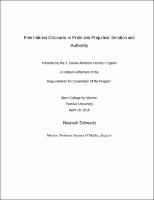Please use this identifier to cite or link to this item:
https://hdl.handle.net/20.500.12202/4172| Title: | Free Indirect Discourse in Pride and Prejudice: Emotion and Authority |
| Authors: | Schwartz, Naamah |
| Keywords: | Austen, Jane, 1775-1817. Pride and prejudice --Criticism and interpretation. Austen, Jane, 1775-1817 --Literary style. Austen, Jane, 1775-1817 --Technique. Point of view (Literature) Indirect discourse in literature. Free indirect speech. |
| Issue Date: | Apr-2016 |
| Publisher: | Stern College for Women |
| Abstract: | Jane Austen has been credited by many as the first English author to make use of free indirect discourse as a means of presenting the thoughts and feelings of the characters in her novels. Free indirect discourse is a narrative technique that combines narrative comment with character voice by presenting a character’s thoughts or feelings within the narrative discourse. This is what Daniel P. Gunn would call “narratorial mimicry” of the character voice within her own discourse (35). Some of Austen’s uses of free indirect discourse are more obvious, in which the character’s voice is noticeable within in a large passage of narration. Other instances are more obscure, in which the narrator’s voice is dominant, and as little as a few words within the narrative discourse can be attributed (usually) to a particular character voice. Much of the scholarship surrounding Austen’s use of free indirect discourse in her novels has been centered on her use of the narrative device specifically in Emma. 1 Pride and Prejudice, which was written and published before Emma, is also rife with instances of free indirect discourse; it is therefore odd that most of the scholarship on Austen’s free indirect discourse focuses on its employment in Emma and pays little to no attention to Pride and Prejudice. Furthermore, the discussion surrounding free indirect discourse in Emma is primarily concerned with the effect it has on what Gunn calls “narrative authority.” Critics have understood free indirect discourse to create a struggle between the narrative voice and the character voice, with each warring for dominance, and ultimately resulting in the defeat of the authoritative narrative voice.2 |
| Description: | The file is restricted for YU community access only. |
| URI: | https://hdl.handle.net/20.500.12202/4172 https://ezproxy.yu.edu/login?url=https://repository.yu.edu/handle/20.500.12202/4172 |
| Appears in Collections: | S. Daniel Abraham Honors Student Theses |
Files in This Item:
| File | Description | Size | Format | |
|---|---|---|---|---|
| Naamah-Schwartz.pdf Restricted Access | 364.91 kB | Adobe PDF |  View/Open |
This item is licensed under a Creative Commons License

